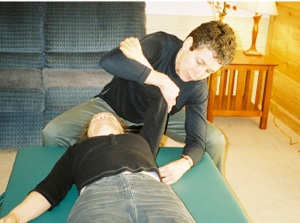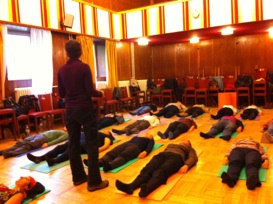Playing music isn't typically thought of as a physically taxing activity, but musical injuries are surprisingly common. And the mental stress of getting to the upper echelons of musicianship (and staying there) can take a tremendous toll on your mental well being. Overuse or improper use of muscles often cause injuries like Tendonitis or Carpal Tunnel and keeping yourself in the right mindset to perform at your best can be surprisingly hard. To keep playing as long as possible, it's important for all musicians to take care of their body and mind, as well as their instrument!
 |
A bronze cast of a woman "playing" the violin which is part of the Metropolitan Museum of Art collection. In addition to not making any sound, playing the violin this way seems very uncomfortable.
|
One of several methods to do this is a physical therapy
technique called the Feldenkrais Method. The goal of the Feldenkrais and Alexander method, a similar treatment, is to use directed attention to retrain the body's habits. By retraining the connections between the body and the brain, the body can learn to improve movements. Rather than curing a specific ailment, the goal is heightened awareness of body movement. For musicians, this can develop a less injury-prone playing technique as well as expand their expressive abilities.
A popular application of these techniques is taught in "
Awareness Through Movement" classes. These are group classes lasting 30 to 60 minutes. A teacher guides students through a series of slow movements, encouraging students to pay careful attention to how their body moves. The second type of class, called "
Functional Integration" is a private class. The instructor usually has the student go through ordinary movements like sitting, standing up, or walking. If the lesson is for a musician, this would also include playing their instrument. During this part, the instructor looks for bad posture or tension in the student and then leads the student through movements designed to reform these habits. The key difference is that Functional Integration involves the instructor moving a student's body through the motions, whereas Awareness Through Movement uses only verbal cues. Scientific studies on the Feldenkrais and Alexander Method give promising results.
 |
Florida Grand Opera performers taking an Alexander Technique class
© FGOpera/ Wikimedia Commons / CC-BY-SA-3.0 / GFDL |
Feldenkrais and Alexander Method classes are offered across the world and can be easily searched for through the
Feldenkrais Guild of North America and
alexandertechnique.com. There are classes specifically directed to musicians as well. "The Harmonious Movement" organizes a variety of workshops including "
Feldenkrais for Musicians" which takes place in Caroga Lake, NY every year as part of the Caroga Arts Collective. The workshop, which lasts from May 30th- June 5th, includes Awareness Through Movement and Functional Integration classes as well as master classes, lessons, and seminars.
Yoga is also commonly used by musicians to maintain their health. Like the Feldenkrais Method or the Alexander Technique, yoga can help musicians become more aware of their body, which can result in healthier playing techniques. An aspect of yoga that the Feldenkrais and Alexander methods are less focused on is mental health. By using breathing and focus exercises, yoga can also help with stress management or performance anxiety.
 |
| The great violinist Yehudi Menuhin was an early proponent of yoga for musicians |
Also, like with the Feldenkrais Method and Alexander Technique, there are many yoga classes and workshops that are targeted toward musicians and performers specifically.
Intermission Sessions, founded by violinists Melissa White and Elena Urioste, hosts frequent yoga sessions and retreats across the US. The yoga in these sessions is focused on performance preparation, meaning they include hand and arm stretches, posture correction, and breathing exercises. The workshops, which last several days, also incorporate meditation. they focus on "music, movement, and mindfulness".
 |
Melissa White, one of the founders of Intermission Yoga
Photo by Kevin Micheal Murphy |
 |
Elena Urioste, the other founder of Intermission yoga
Photo by Daniel Cavazos |
Besides taking classes, you can also read up on the topic!
Playing Less Hurt by Janet Horvath, former principal cellist of the Minnesota Orchestra. The book is a guide for all musicians on how to play with healthy technique and good posture. It provides stretches, advice on how to have a long and healthy career, and addresses the destructive "no pain, no gain" mentality of many musicians. She also wrote a piece in
The Atlantic titled A Musician Afraid of Sound, where she writes about her experience with an ear injury that left her hypersensitive to sound. I would highly recommend giving both a read.
Going through these extra steps to keep yourself healthy as a musician is hard work, but it's absolutely necessary. Hopefully, this blog post has encouraged you to be more conscious of your playing, how it affects you, and how your mind and body health affect your playing.








No comments:
Post a Comment